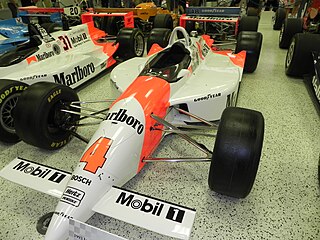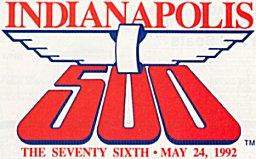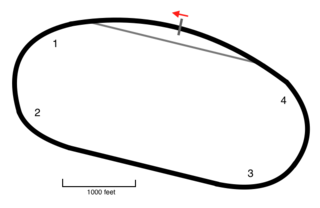
Robert Woodward Rahal is an American former auto racing driver and team owner. As a driver he won three championships and 24 races in the CART open-wheel series, including the 1986 Indianapolis 500. He also won the 2004 and 2020 Indy 500s as a team owner for Buddy Rice and Takuma Sato, respectively.

Roberto José Guerrero Isaza is a Colombian-American former race driver. He participated in 29 Formula One Grands Prix, debuting on 23 January 1982, becoming the first Colombian to start a Formula One Grand Prix.

James Vasser Jr. is an American former racing driver. Vasser won the 1996 CART IndyCar championship with Chip Ganassi Racing, and scored ten victories in the series. Vasser was the last American to win the CART championship.
Chip Ganassi Racing, LLC (CGR), also sometimes branded as Chip Ganassi Racing Teams, is an American auto racing organization with teams competing in the NTT IndyCar Series, IMSA WeatherTech SportsCar Championship, FIA World Endurance Championship, and Extreme E. They have formerly competed in the NASCAR Cup and Xfinity Series, Global Rallycross Championship and the Rolex Sports Car Series. It was founded in 1990 by businessman and former racecar driver Chip Ganassi, from the assets of Patrick Racing to compete in the CART IndyCar World Series.

Rahal Letterman Lanigan Racing is an auto racing team that has participated in the WeatherTech SportsCar Championship and the IndyCar Series. Headquartered in Brownsburg, Indiana and Hilliard, Ohio, it is co-owned by 1986 Indianapolis 500 winner Bobby Rahal, former television talk show host David Letterman, and businessman Mike Lanigan. The team won the Indianapolis 500 twice in 2004 and 2020 with Buddy Rice and Takuma Sato.

Patrick Racing was an auto racing team in USAC, CART, Champ Car and the Indy Racing League. Patrick Racing was started by U.E. "Pat" Patrick in the 1970s. The team is best known for winning the Indianapolis 500 on three occasions, and the Indy car title twice. Patrick Racing acheived 45 Indy car wins.
Michael Dennis Groff is a former race car driver who competed in CART and the IRL IndyCar Series and was the 1989 Indy Lights champion. His younger brother Robbie was also a CART and IRL driver from 1994 to 1998.

The 79th Indianapolis 500 was held at the Indianapolis Motor Speedway in Speedway, Indiana on Sunday, May 28, 1995. Sanctioned by USAC, it was part of the 1995 CART PPG Indy Car World Series season. Jacques Villeneuve won in his second start. After dominating the 1994 race and the 1994 IndyCar season, Marlboro Team Penske failed to qualify for the race. Two-time and defending Indy 500 winner Al Unser Jr. and two-time winner Emerson Fittipaldi (bumped) could not get their cars up to speed. A noticeable period of decline followed for the team until 2000 when Gil de Ferran won the CART championship, and subsequently the team returned to Indianapolis in 2001.

The 78th Indianapolis 500 was held at the Indianapolis Motor Speedway in Speedway, Indiana on Sunday, May 29, 1994. The race was sanctioned by United States Auto Club (USAC), and was included as race number 4 of 16 of the 1994 PPG IndyCar World Series. For the second year in a row, weather was nary a factor during the month. Only one practice day was lost to rain, and pole day was only partially halted due to scattered showers. Warm, sunny skies greeted race day.

The 77th Indianapolis 500 was held at the Indianapolis Motor Speedway in Speedway, Indiana on Sunday, May 30, 1993. Emerson Fittipaldi took the lead with 16 laps to go, and won his second career Indy 500 victory. The race was sanctioned by USAC and was part of the 1993 PPG Indy Car World Series. Several sidebar stories during the month complemented one of the most competitive Indy 500 races in recent years.

The 76th Indianapolis 500 was held at the Indianapolis Motor Speedway in Speedway, Indiana, on Sunday, May 24, 1992. The race is famous for the fierce battle in the closing laps, as race winner Al Unser Jr. held off second place Scott Goodyear for the victory by 0.043 seconds, the closest finish in Indy history. Unser Jr. became the first second-generation driver to win the Indy 500, following in the footsteps of his father Al Unser Sr. He also became the third member of the famous Unser family to win the race.

The 75th Indianapolis 500 was held at the Indianapolis Motor Speedway in Speedway, Indiana, on Sunday, May 26, 1991. Rick Mears won from the pole position, becoming the third four-time winner of the Indy 500, joining A. J. Foyt and Al Unser. During time trials, Mears also established an Indy record by winning his sixth career pole position. The month of May for Mears was tumultuous, as he suffered his first ever crash at Indy since arriving as a rookie in 1977. The wreck during a practice run totaled his primary car, and broke a bone in his right foot. Mears kept the injury mostly secret, and later admitted that the pain he experienced during the race was so bad, he had to cross his legs in the car and push the accelerator pedal down with his left foot.

The 74th Indianapolis 500 was held at the Indianapolis Motor Speedway in Speedway, Indiana on Sunday, May 27, 1990. Dutchman Arie Luyendyk took the lead with 32 laps to go, and earned his first-ever victory in championship-level competition. It was the second consecutive year the Indy 500 was won by a foreign-born competitor, the first time that had occurred since 1965–1966. Luyendyk completed the 500 miles at an average speed of 185.981 mph (299.307 km/h), a record that stood for 23 years until 2013. In reference to the long-standing speed record, the 1990 race had often been referred to as "The Fastest 500."

The Firestone Indy 400 was an IndyCar Series race held at Michigan International Speedway in Brooklyn, Michigan. The event was most recently held in 2007. From 1981 to 2001, the event was better-known as the Michigan 500, and was held in high prestige. During its heyday of the 1980s, the race was part of Indy car racing's 500-mile "Triple Crown".

The 1993 PPG Indy Car World Series season was the 15th national championship season of American open wheel racing sanctioned by CART under the name "IndyCar". The season consisted of 16 races. Nigel Mansell was the national champion as well as the Rookie of the Year. The 1993 Indianapolis 500 was sanctioned by USAC, but counted towards the CART points championship. Emerson Fittipaldi won the Indy 500, his second career victory in that event.

The 1987 CART PPG Indy Car World Series season was the 9th national championship season of American open wheel racing sanctioned by CART. The season consisted of 16 races, and one non-points exhibition event. Bobby Rahal was the national champion, winning his second-consecutive title. The rookie of the year was Fabrizio Barbazza. The 1987 Indianapolis 500 was sanctioned by USAC, but counted towards the CART points championship. Al Unser won the Indy 500, his record-tying fourth victory at Indy.

Galles Racing is a former auto racing team owned by Rick Galles that competed in the CART series, Can-Am and the Indy Racing League. The team won the 1990 CART championship as well as the 1992 Indianapolis 500 with driver Al Unser Jr. The team won a total of 21 Indy car races along its history. In addition to Unser's 1992 victory, the team finished second at Indianapolis on three separate occasions.

Truesports was an automobile racing team founded by Jim Trueman based in Hilliard, Ohio. The team is best known for winning the 1986 Indianapolis 500 and back-to-back CART championships in 1986 and 1987. The team won 19 points-paying Indy car races.
Hogan Racing was a racing team owned by Carl G. Hogan, owner of Hogan Trucking.

The Ilmor-Chevrolet 265-A is a turbocharged, 2.65 L (162 cu in), V-8 Indy car racing engine, designed and developed by Ilmor, in partnership with Chevrolet, for use in the CART PPG Indy Car World Series; between 1986 and 1993.



















